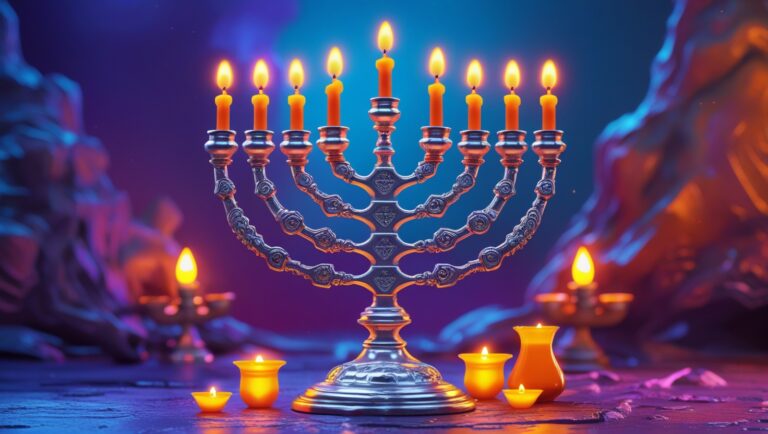The Kidush cup represents Malkhut and the wine is associated with the Mokhin of Binah (of Binah) entering on Shabbat night
To be honest this ended up being a lot longer than I intended simply because there’s no way to simplify the Kavanot of the Kidush. While these are not all there is about, it still gives a pretty good taste of the wonderful work Hashem has given us. If you haven’t seen the previous article on receiving the extra souls of Shabbat, you can read it here.
So let’s begin.
On Shabbat, the entire Partzuf HaYomi (dealing with day-by-day Avodah), has an elevation until the Sephira of Keter during the time of Mincha, also called Ra’ava D’Ra’avin (desire of desires). This is a time when Zeir Anpin and Nukva (ZON) of Atzilut receive Mochin (divine intellect) from that exalted level, and send down to us in Beriyah, Yetzirah and Assiyah.
During weekdays, ZON get Mochin only from the lower 3 Sephirot Netzach, Hod and Yesod of Tevunah (the lowest possible level), due to the constraints of the spiritual state of Creation. However, during Shabbat there’s an elevation and all the Mitzvot, every single word of Torah is worth much more.
Specifically, during Shabbat night we get the Mochin from CHAGAT (Chesed, Gevurah and Tiferet) of NAHY (Netzach, Hod and Yesod), but only the CHAGAT and NAHY of that level (of Binah), which means we are not yet receiving CHABAD. The CHABAD (of Binah) comes during the morning prayers, together with the general Chokhmah (which includes Shacharit and Mussaf), while Keter comes with Mincha (NAHY and CHAGAT) and, according to the Shemen Sasson, with the Seuda Shlishit (CHABAD of Keter).
The table below shows the Mochin that Zeir Anpin and the Shekhina get on Shabat night. The usual order, and the one we get here, is that Zeir Anpin gets from Binah the Mochin and passes all the Malkhuyot to the Shekhina.
Note that we are only dealing with Mochin of Binah here on Shabbat night. It might seem intimidating, but once you understand, it becomes easy to keep in mind:
Entering home on Shabbat Night
The Arizal teaches us on Shaar HaKavanot that on Friday night, after returning home from synagogue and saying “Shabbat Shalom” upon entering, one should kiss their mother’s hand (if she’s present). This gesture hints at the entry of the spiritual intellect (mochin) of the sefirot Chesed, Gevurah, and Tiferet (CHAGAT) from the higher worlds (Yesod and Tiferet of the Supernal Mother, also known as Binah) that come to Zeir Anpin on Shabbat.
As we saw in the introduction, during the week, only a lower level of mochin (represented by the Nehi—Netzach, Hod, and Yesod—of Tevunah) enters Zeir Anpin. These are referred to as the intellect of the “Tzadi” in the Tzelem (image) of the soul. On Shabbat night, the higher intellect of CHAGAT enters, symbolized by the letter “Lamed” in the Tzelem.
Encircling the table
It is a minhag in Kabbalah that the man of the household should encircle the table to bring down the Makifim (encircling Mochin), which is the counterpart of the Mochin of Panim (internal aspect) that is done with the Kidush.
This is from Shaar HaKavanot (check the table above):
- When the mochin (spiritual intellect) of the lower sefirot (NAHI—Netzach, Hod, and Yesod) of the “Lamed” in the Tzelem (spiritual image) from the outer aspect of Yesod and Tiferet of the Supernal Mother (Yesod and Tiferet of Yesod and Tiferet) come during the recitation of the Shema and the Amidah on Friday night, the Sefira of Malchut (i.e. the Shekhina) is called “Chakal” (field). “Chakal” means “field,” which corresponds to the NAHI.
- When the mochin of the higher sefirot (Chesed, Gevurah, and Tiferet) of the “Lamed” in the Tzelem come during the “Me’en Sheva” blessing of Friday night’s prayer, Malchut is then called “Tapuchin” (apples), representing Chesed, Gevurah, and Tiferet, as is known.
- When the mochin of Chochmah, Binah, and Da’at (Chabad) of the “Lamed” in the Tzelem come during Kidush on Friday night, Malchut is then called “Kadishin” (holy), and at that point, it is referred to as “Chakal Tapuchin Kadishin” (the holy apple field).
Therefore, when a person comes home and prepares to recite Kidush, during which the mochin of Chabad from the “Lamed” in the Tzelem of the outer aspect of Yesod and Tiferet will enter, after saying “Shabbat Shalom” and kissing their mother’s hand, they should stand in their place and say, “This is the meal of the holy apple field.”
This signifies that all the actions they are now performing in preparation for the Kidush are part of drawing down the mochin of CHABAD (of CHAGAT) from the outer aspect of Yesod and Tiferet, which will then flow into Malchut and complete the state of “Chakal Tapuchin Kadishin.”
The Malkhut (Sovereignty) of these specific mochin from Yesod and Tiferet of the Supernal Mother is transmitted from the corresponding aspects of Chesed, Gevurah, and Tiferet in Zeir Anpin to the same Sefirot in Nukva (the Shekhina, representing the receiving aspect). For example, the mochin that come during the “Boi Kallah” section of the prayer represent the mochin of Netzach, Hod, and Yesod of Chesed, Gevurah, and Tiferet of the inner aspect of Yesod and Tiferet de Yesod and Tiferet. These mochin first enter Zeir Anpin and then extend to Nukva, corresponding to the same Sefirot in her, like a mirror.
Now, through the two circuits around the table, we aim to draw down the Malkhut of these mochin from Zeir Anpin to Nukva. The malchut of these mochin is composed of both an inner light (Ohr Pnimi) and a surrounding light (Ohr Makif). The mochin of the inner light have already been drawn into Nukva during the Tefilah, as seen in the table. Through the circuits around the table, we focus on drawing the Malchut of the mochin from Zeir Anpin to Nukva in the form of the surrounding light.
Here is the detailed meditation for the circuits: In the first circuit, we draw down two aspects of the malchut of the mochin in the form of surrounding light:
- From the mochin of Netzach, Hod, and Yesod of Chesed, Gevurah, and Tiferet of the inner aspect of Yesod and Tiferet de Yesod and Tiferet, which were drawn during the Shema and Amidah, we now draw down the malchut of these mochin in the form of surrounding light to Netzach, Hod, and Yesod of Chesed, Gevurah, and Tiferet of the inner aspect of Bina (understanding) of Zeir Anpin.
- From the mochin of Chesed, Gevurah, and Tiferet of the inner aspect of Yesod and Tiferet de Yesod and Tiferet, which were drawn during the “Barechu” prayer and the “Ufros” section of the Amidah, we now focus on drawing the malchut of these mochin in the form of surrounding light to Chesed, Gevurah, and Tiferet of the inner aspect of Bina of Zeir Anpin.
In the second circuit, we continue by drawing down two more aspects of the malchut of the mochin in the form of surrounding light:
- From the mochin of Chochmah, Binah, and Da’at (Chabad) of Chesed, Gevurah, and Tiferet of the inner aspect of the intellective aspect of the Supernal Mother, which were drawn during the “Vayechulu” prayer following the Amidah, we now aim to draw the malchut of these mochin in the form of surrounding light to Chochmah, Binah, and Da’at of Chesed, Gevurah, and Tiferet of the inner aspect of Bina of Zeir Anpin.
- From the mochin of Chesed, Gevurah, and Tiferet of the inner aspect of Yesod and Tiferet de Yesod and Tiferet, which were drawn during the “Me’en Sheva” blessing, we now focus on drawing the malchut of these mochin in the form of surrounding light to Chesed, Gevurah, and Tiferet of the inner aspect of Bina of Zeir Anpin.
This is the Kavanah of the Mochin of Makkifim being brought down:
Smelling the Hadas
It’s a custom from the Zohar and the Talmud that one should smell Hadas (myrtle branches) on Shabbat. Before the second circuit around the table, one should take the Hadassim, recite the blessing over them, and smell them. Afterward, one should circle the table a second time while holding the myrtle branches.
The secret behind using Hadassim specifically for the second circuit is they symbolizes Chesed, Gevurah, and Tiferet (Chagat), representing the drawing down of the surrounding lights (Ohr Makif) of Chagat in this circuit. The mystical significance of using two bundles of Hadas, as explained by the sages in Massechet Shabbat corresponds to Zeir Anpin and Nukva (the masculine and feminine divine aspects). This symbolizes the intention of the circuits, which is to draw the surrounding light from Zeir Anpin to Nukva.
Even if one is unable to obtain valid myrtle branches, they should still perform the second circuit around the table without the myrtle and focus on the spiritual intentions of the circuit. This is further elaborated in the sacred texts Shemen Sasson (Part 3, page 91, letter 36) and Sfat Emet by Rabbi Eliyahu Mishan (page 230b), which both emphasize this point.
With the bracha of Hadassim, one should also be mekaven the Yichud of smelling which we will leave for another post. If you know the kavanot of the formula of the Bracha (Matbeah HaBracha), you should also use it.
Order of the Kidush on Shabat Night
One should recite the Psalm “Mizmor L’David” before Kidush and focus on the last verse of the Psalm, which contains the acronym for “Only goodness and kindness shall follow me” (Ach Tov VeChesed), with the final letters spelling the name of God (the Tetragrammaton). On Friday night, one should also focus on this full name (milui) being spelled with the full Yud’s. (יוד הי ויו הי)
The cup should rest properly on the fingers and palm, and not with the fingers gripping the cup around its sides.
The Shemen Sasson, in his commentary on Sha’ar HaMitzvot, Parashat Eikev, writes that the word Gibeihim (on their bases) appears in parentheses, and he suggests the correct reading is Govahem (on their heights), meaning that one should hold the Kidush cup with the fingers pointing upwards, resting on their heights. This way, the cup is truly held upon the heights of the fingers.
In general, the act of Kidush draws forth an illumination from the intellectual faculties (Mochin) of the upper three sefirot (Chochmah, Binah, and Daat—Chabad) of Zeir Anpin to Nukva, who stands in the lower sefirot (Netzach, Hod, and Yesod—Nahi) of Zeir Anpin. This illumination is divided into two categories: internal light (Ohr Pnimi) which comes through the act of holding the cup with specific intentions, and surrounding light (Ohr Makif) which comes through the recitation of Kidush.
Before the Kidush, through the act of holding the cup and reciting the Kidush, we intend to once again draw down the illumination of these faculties from Zeir Anpin to Nukva. This is divided, as mentioned earlier, into Ohr Pnimi, which comes through the act of Kidush, and Ohr Makif, which comes through the words of Kidush. However, it is important to note that the intellectual faculties being drawn through the act and speech of Kidush, and which are divided into Ohr Pnimi and Ohr Makif, are specifically related to Ohr Pnimi, as we do not have the power to draw down Ohr Makif of these faculties, as the Arizal explicitly states.
Even though the intellectual faculties of Chochmah, Binah, and Daat of Chagat of Tevunah have already been drawn down during the Vayechulu after the Amidah to Zeir Anpin and Nukva, what is the need to draw them again now? The Shemen Sasson explains in Petach Einayim (page 70b) in his commentary on the introduction to the Minchah prayer of Friday afternoon (and similarly in Petach Einayim, page 61a, in his commentary at the end of section 5) that the intellectual faculties of Friday night are repeated several times.
In addition to the allusion in the wine of Kidush to drawing the intellectual faculties from Zeir Anpin to Nukva, there is also a hint to drawing an illumination from the Keter of Zeir Anpin to Nukva. This is because from the Keter of Zeir Anpin to the chest (Tiferet) of Zeir Anpin, where Nukva stands, there are seven sefirot, which are the intellectual and emotional sefirot (Chabad and Chagat). Each of these seven sefirot contains ten aspects, making a total of seventy, which is the numerical value of the word Yayin (wine).
We must understand why the Arizal wrote that we should draw illumination from Chabad and Chagat of Keter, and not simply from Chabad and Chagat of Zeir Anpin, as is implied in the straightforward reading of Sha’ar HaKavanot and Pri Etz Chaim, as well as from the Machberet HaKodesh. There it appears that the illumination is drawn from the Keter of Zeir Anpin, where there are seven sefirot, each of which contains ten aspects, totaling seventy, corresponding to the numerical value of Yayin.
During Kidush on Shabbat day, one should dilute the wine with water with these intentions in mind, as it is written in Sha’ar HaGilgulim, introduction 39, and Sha’ar HaMitzvot, Parashat Eikev, to focus on this intention when diluting the wine for the blessing of the meal, in the second blessing at the phrase “And you shall eat and be satisfied, and bless…”
The secret of diluting the wine with water, as explained by the Arizal in Sha’ar HaMitzvot, Parashat Eikev, is that wine symbolizes judgment and severity (Gevurah), while water symbolizes kindness (Chesed). Therefore, by diluting the wine, we intend to sweeten the severities with kindness.
Kavanot of saying the Kidush while holding the cup
You may recall the table at the beginning of this article where it shows the Mochin we are bringing to the Partzufim during the Kidush. The Mochin are represented by the names יהוה for the internal light (pnimi) and אהיה for the surrounding light (makif) with the respective nekudot for each of the Sephirot on them (see there).
Well, here on the Kidush we are bringing in the Mochin of Pnimiut of this night and it goes like this:
Then we say Savri Maranan with the following Kavanot:
Then we bless the bracha for the wine (or grape juice) with the Matbea Bracha. Some other Kavanot also follow when you finish this blessing:
Then immediately we move on to the blessing to sanctify this night (Kedushat HaYom). I will skip the beginning since in the Siddurim it’s written with the Matbea Bracha (explained above) and move to the end:
Yet, it is a principle in Kabbalah that all the Kavanot we do for the blessings themselves are only for the ל and מ of the Mochin that we bring down (the Makifim). Once we do the act (in this case, of drinking), we should have in mind to bring down the צ. Note that all these letters form the full construct of the Tzelem (צלם) of the particular Avodah we are performing.
And here’s the Kavanah for the צ when drinking:
Other Kavanot for the Kidush
The Arizal also teaches us to be mekaven one of the Yods of the 9 miluyim of ע״ב ס״ג מ״ה ב״ן which must be directed to each one of the letters of the holy name of ב״ן which is יוד הה וו הה, when saying in each of the letters of the Bracha of the wine as below:
After drinking the wine (or grape juice), we recite the Atkinu Seudata invitation to announce we are partaking from Hashem’s meal with the corresponding Partzuf (Chakal Tapuchin Kadishin). There’s a very interesting Chiddush in Massechet Pessachim that the sages teach that Yom Tov should be “half for us and half for Hashem”, meaning we are partaking half for our own good. Yet, on Shabbat, all comes from Hashem.
R’ Daniel Frisch explains that this is the reason why we have an obligation from the Zohar to invite poor guests to feed them on Yom Tov; because we have half of the meal for us. This is related to the fact that Yamim Tovim days are decreed by the earthly beit din. Yet, on Shabbat we have no such obligation (though it’s certainly praiseworthy) since it is Hashem who arranges everything and we are the guests. So we are “inviting ourselves” to the meal.
Concluding remarks
The above should give an idea of how awesome are the Mitzvot we have and how great is the work we do in the seemingly simple act of sanctifying Shabbat night. I realize this is a lot, but every little we perform adds up and we see how many opportunities we have to bring down kedusha and ohr (light).







